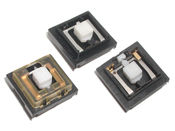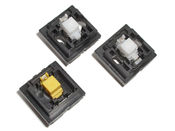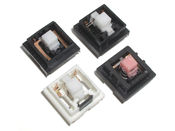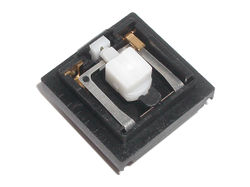RAFI full-travel key switch
RAFI full-travel key switch refers to RAFI RS 74 and RS 76 series keyboard switches.
Contents
Overview
RAFI's terminology is not consistent. Chapter 5 of the 2001 RAFI catalogue is titled "PCB Keyswitches", and chapter 4 of the 2016 catalogue is called "PCB Key Switches"; in both catalogues, these chapters cover all types of small, compact pushbutton switches. However, the tables of contacts only use "keyswitch"/"key switch" to refer to keyboard switches, with other switch types described with such terms as "tactile switches", "main switches" and "pushbuttons".
In RAFI terms, "full travel" indicates a total travel 2.5 mm or more.[1]
The family was introduced in 1975. All switches use the same square keycap mount.
RS 74 M switches in a Neve Necam 96 keyboard
Sub-families
 |
RAFI RS 74 C — 2.5 mm travel, Hall effect Discontinued |
 |
RAFI RS 74 M — 2.5 mm travel, mechanical Discontinued |
 |
RAFI RS 76 C — 4 mm travel, Hall effect |
 |
RAFI RS 76 M — 4 mm travel, mechanical RAFI RS 76 MX — 4 mm travel, mechanical, translucent |
Characteristics
RS 74 and RS 76 families share various characteristics:
- Flat metal contact loop in the mechanical series (RS 74 M and RS 76 M)
- Centimetre guides: many switches feature a 1 cm ruler, graded in 2 mm intervals; the purpose of this is not known (RS 74 M covered switches do not feature this, but RS 74 M open switches do)
- Use of miniature parts
- PCB standoffs have room for a stabiliser wire (this can be seen in the RAFI Compudent keyboard)
Lower shell of RAFI RS 76 M (diode) yellow, showing the standoffs
Codes
RS 76 switches are often found with codes stamped into the top of the switch. For a code such as "1245 502H", found in switch family RS 76 M, this gives part number 3.13.002.502. The meaning of "H" and the preceding digits is not known. Comparison of two "1245 502H" switches shows that a stamp tool was used, as the tracking and orientation of the characters is entirely consistent between switches; the writing appears to be recessed, suggesting that the switch was stamped, as mould stamps lead to raised text in the moulded article. The [2] keyboard is a counterexample of RS 76 M where the stamped numbers don't appear to include the switch part number, only the preceding digits, which may indicate the batch number.
Many moulds themselves feature part number codes on the bottom (e.g. ".516" for "1245 502H"), but these do not appear to correspond to switch part numbers and may instead indicate the mould pattern, as moulds were shared between switch variants; this may explain why the specific switch part numbers were often stamped in afterwards.
Miniature parts
Every RAFI switch family features very small parts:
- The magnet in RAFI RS 76 C is 2 mm wide, 3 mm tall and 1 mm deep
- The latching slide block in RS 74 M is 2.8 mm wide and 3.9 mm tall
- The follower pin in RS 74 M is around 3.2 mm long; the part that rides on the pressure spring is 1 mm diameter and around 1.9 mm long, while the part that runs inside the latch track is a mere 0.5 mm diameter and around 1.4 mm long (getting accurate measurements of such a fiddly part proved too difficult)
- The follower spring in RS 74 M is 2.7 mm long and 0.9 mm diameter
- The stationary contact in the diode version of RS 76 M is 1.7 mm wide, 2.6 mm tall and 0.9 mm high
All such parts are easy to lose during disassembly and inspection!
Latching system
RAFI's latching system comprises several very small parts. The latch track is contained by a small slide block, and is followed by a tiny pin supported by a 2.7 mm long (0.9 mm diameter) spring inside the slider. The slide block dimensions vary slightly, but the same mechanism is used by both the 2.5 mm and 4 mm travel designs.
Lubrication
The 2001 catalogue has additional information on manufacturing processes, which includes the following text:
- Cleaning
- Keyswitches should not be washed in freon or similar substances as a lubricant is used, otherwise operating life of the keyswitches will be reduced.
Such lubricant has yet to be visibly observed.
References
- ↑ RAFI — Langhubsysteme
- ↑ Deskthority — RAFI DT-02














